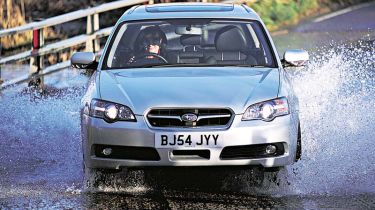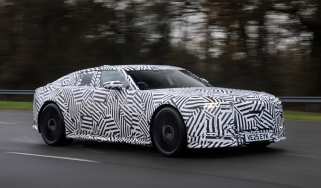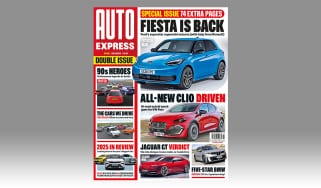Subaru Legacy
Here are some economy figures for you. If you were driving a Laguna with a 3.0-litre V6 under the bonnet, Renault says you should return 28mpg. If it was a six-cylinder BMW 3-Series, it would be 31mpg. So why does Subaru reckon we should manage a mere 23.7mpg from the newest member of our long-term fleet, the Legacy Sports Tourer 3.0R Spec B? And more importantly, why am I actually only getting a shade more than 20mpg?

Here are some economy figures for you. If you were driving a Laguna with a 3.0-litre V6 under the bonnet, Renault says you should return 28mpg. If it was a six-cylinder BMW 3-Series, it would be 31mpg. So why does Subaru reckon we should manage a mere 23.7mpg from the newest member of our long-term fleet, the Legacy Sports Tourer 3.0R Spec B? And more importantly, why am I actually only getting a shade more than 20mpg?
Perhaps the clue is in the name. The Sports Tourer is certainly fast; it covers 0-60mph in 6.6 seconds and has a 145mph top speed. So is this a performance car masquerading as a load-lugger? A Subaru spokesman told me: "Yes, it's a sporting model rather than a workhorse estate. It has a version of the six-speed gearbox found in the Impreza STi, and is set up deliberately to be like that." He added that he too was running a Spec B, and had managed up to 29mpg on motorway runs.
I've got nowhere near that. The car's trip computer says I'm averaging around 22mpg - doing the maths myself, the actual figure is 20.1mpg. I thought maybe it was just me and my heavy size twelves, but it's not. Everyone who has driven the Legacy loves its handling, yet the word I hear most often as they throw the keys back to me is "thirsty". Economy aside, the Spec B is a fun car. The ride is sporty and firm, and Subaru's four-wheel-drive system helps it grip the road. With more than 3,600 miles on the clock, it's well run in, although the steering has loosened up a little too much - there's not enough feedback through the wheel.
The boot is a decent size, and with the seats down, there's 1,628 litres of space. The rollerblind-style cover is great for hiding cargo, but annoyingly it doesn't extend to the tailgate. This means there's a tiny gap through which eagle-eyed thieves will be able to see. There's a cover that clips to the inside of the rear window which is supposed to plug the hole. However, every time I slam the lid it bends out of shape - so I've given up on it.
The cabin layout is simple and stylish, but it's not actually very big inside. Two smallish children and one adult in the rear all moaned about how squashed they felt. The driving position isn't great, either; with the steering wheel in its highest position, I still feel I want to be sitting lower in order to be in the right place for a comfortable drive.
These aren't the only design flaws to blight the Subaru. The armrest between the front seats is too low to be of any use, and you only have a few seconds to start the car after unlocking it before it re-immobilises itself. However, I love the sunroof; it's massive and gives a feeling of airiness.
The sat-nav has been a disappointment. It's a touch-screen system that should be a joy to use, and it is when it's working. But more often than not, it won't allow me to select certain options. Subaru engineers suspect it's a software problem and are sending a new CD-ROM. I'll let you know what happens. As well as fuel bills, my wallet has been hit by servicing. Because of the car's sporting attributes, Subaru recommends a 1,000-mile check-up. Everything was okay, but this set me back £150.
Cost and design niggles aside, there's much to like about the Spec B. It's a world away from the 'wardrobe on wheels' tradition of estates, and its understated looks turn heads. It's faster and more sure-footed than many rivals, and is worth considering if you need cargo-carrying ability, but don't want to sacrifice the driving experience. And while it may have its flaws, the Subaru is a more individual choice than some German executives.



